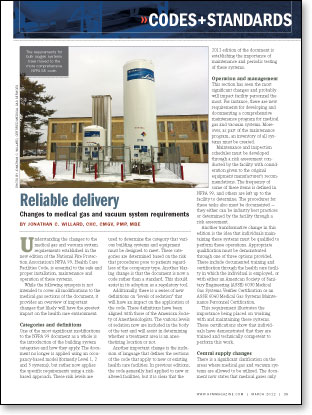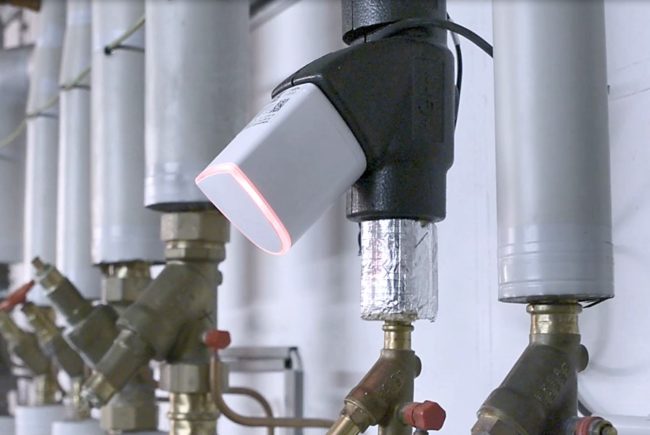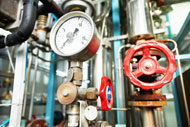 Understanding the changes to the medical gas and vacuum system requirements established in the new edition of the National Fire Protection Association's NFPA 99, Health Care Facilities Code, is essential to the safe and proper installation, maintenance and operation of these systems.
Understanding the changes to the medical gas and vacuum system requirements established in the new edition of the National Fire Protection Association's NFPA 99, Health Care Facilities Code, is essential to the safe and proper installation, maintenance and operation of these systems.
While the following synopsis is not intended to cover all modifications to the medical gas sections of the document, it provides an overview of important changes that likely will have the greatest impact on the health care environment.
Categories and definitions
One of the most significant modifications to the NFPA 99 document as a whole is the introduction of the building system categories and how they apply. The document no longer is applied using an occupancy-based model (formerly Level 1, 2 and 3 systems), but rather now applies the specific requirements using a risk-based approach. These risk levels are used to determine the category that various building systems and equipment must be designed to meet. These categories are determined based on the risk that procedures pose to patients regardless of the occupancy type. Another blaring change is that the document is now a code rather than a standard. This should assist in its adoption as a regulatory tool.
Additionally, there is a series of new definitions on "levels of sedation" that will have an impact on the application of the code. These definitions have been aligned with those of the American Society of Anesthesiologists. The various levels of sedation now are included in the body of the text and will assist in determining whether a treatment area is an anesthetizing location or not.
Another important change is the inclusion of language that defines the sections of the code that apply to new or existing health care facilities. In previous editions, the code generally had applied to new or altered facilities, but it is clear that the 2012 edition of the document is establishing the importance of maintenance and periodic testing of these systems.
Operation and management
This section has seen the most significant changes and probably will impact facility personnel the most. For instance, there are new requirements for developing and documenting a comprehensive maintenance program for medical gas and vacuum systems. Moreover, as part of the maintenance program, an inventory of all systems must be created.
Maintenance and inspection schedules must be developed through a risk assessment conducted by the facility with consideration given to the original equipment manufacturer's recommendations. The frequency of some of these items is defined in NFPA 99, and others are left up to the facility to determine. The procedures for these tasks also must be documented — they either can be industry best practices or determined by the facility through a risk assessment.
Another transformative change in this edition is the idea that individuals maintaining these systems must be qualified to perform these operations. Appropriate qualification must be demonstrated through one of three options provided. These include documented training and certification through the health care facility in which the individual is employed, or with either an American Society of Sanitary Engineering (ASSE) 6030 Medical Gas Systems Verifier Certification or an ASSE 6040 Medical Gas Systems Maintenance Personnel Certification.
This requirement illustrates the importance being placed on working with and maintaining these systems. These certifications show that individuals have demonstrated that they are trained and technically competent to perform this work.
Central supply changes
There is a significant clarification on the areas where medical gas and vacuum systems are allowed to be utilized. The document now states that medical gases only are allowed in areas where they will be used under the direction of a licensed medical professional for the following purposes:
- Direct respiration by patients;
- Clinical application of the gas to a patient;
- Medical device applications directly related to respiration;
- Power for medical devices used directly on patients;
- Calibration of medical devices intended for 1 through 4 above.
These requirements clarify the allowed uses and applications for medical gases and help eliminate uses that are not congruent with these requirements (i.e., blowing down or drying medical scopes).
Another update to the code is the removal of the requirements for indoor ventilation of central supply system locations and cylinder storage rooms from Chapter 5. These requirements are now under the purview of the mechanical systems committee and are found in the new HVAC chapter. The requirements have gone through a significant overhaul and no longer use the "3,000-cubic-feet of gas" threshold to determine the indoor ventilation requirements. This chapter is worth reviewing to understand the revised requirements.
Another reorganization of the code is the removal of the requirements for bulk oxygen central supply systems from Chapter 5. Most of these now reside in the more comprehensive NFPA 55, Compressed Gases and Cryogenic Fluids Code. Also, because other bulk gas systems have become part of the fold, there are defined capacities for these systems and the specific codes or standards used to determine design criteria. For example, bulk systems for inert gases, such as nitrogen, must comply with the Compressed Gas Association P-18, Standard for Inert Gases at Consumer Sites.
A change that will impact the ability of design professionals to add on to existing central supply systems is a new allowance for control equipment (i.e., final-line pressure regulators) to be located remotely from the source equipment, such as when single, central supply systems operate at multiple pressures.
In previous editions, the control equipment and pipelines for both operating pressures would need to originate at the source of supply. Now, in cases where a bulk oxygen system is remote from the building, the existing pipeline could be split inside the building and different operating pressures could be achieved at that location rather than at the source. In the past, when adding an elevated pressure hyperbaric oxygen pipeline to an existing system, a new pipeline would have to be installed all the way back to the source system. This is no longer necessary, and a substantial savings can be realized in the installation costs. However, the control equipment that is remote must be installed within a secure enclosure to prevent unauthorized access.
There also have been some minor modifications to the quality of medical air required when using medical air compressor systems. The requirements have become a bit more stringent for particulate matter. The medical air compressor intake location and clearance requirements also have been aligned with the Facility Guidelines Institute's Guidelines for Design and Construction of Health Care Facilities. Additionally, the seal water used for liquid-ring compressor systems must be treated, and there are new monitoring requirements for liquid-ring compressor systems that are used in medical air production.
Furthermore, a new central supply system for medical air is introduced in this edition. The code now allows for the use of medical air proportioning systems to create synthetic air. These systems use a blending technology to mix nitrogen and oxygen to make medical air. This would eliminate the need to operate and maintain medical air compressor systems and provide for an alternative to the current manifold or compressor technologies available today.
Because medical-surgical vacuum and waste anesthetic gas disposal (WAGD) systems have been allowed to be combined for some time, some further restrictions were needed. In recent years, there have been a few fires in combined vacuum and WAGD systems. These fires occurred in systems that utilized oil-lubricated vacuum pumps. In previous editions, the allowable amount of oxidizing gases to enter into the oil-lubricated pumps was never clearly defined. Now, if these two systems are combined, the total concentration of oxidizers (oxygen and nitrous oxide) shall be maintained at less than 23.6 percent. If this cannot be achieved, the vacuum pumps must comply with the requirements for WAGD vacuum pumps, which essentially use lubricants and sealants that are inert in the presence of oxidizers. Another small change is that all vacuum exhaust piping now must be exhausted away from "areas of public assembly."
Pipeline systems, components
In another revision, the requirements for the location of zone valves have been reinforced. It always has been the intent to locate zone valves outside of the areas that they control. Due to changes in the architectural design and layout of treatment areas, this requirement now has been stated clearly and a zone valve shall not be located in a room with station outlets and inlets that it controls. This will allow for these emergency control valves to be used in the event of a fire, reducing the chance of placing the operator in harm's way.
Because zone valves must be located immediately outside of each vital life-support area, critical care area and anesthetizing location, the new definition of the levels of sedation is relevant. These zone valves now are required only in anesthetizing locations for moderate sedation, deep sedation and general anesthesia. Minimal sedation has been left out of the requirement for individual zone valves for each of these locations. For the engineering community, this may cause a bit of confusion, but the burden is on the organization to determine which sedation levels are anticipated in the various treatment locations.
In-line check valves used in the pipeline distribution systems now are required to be similar in design to that of shutoff valves. They must be made of brass or bronze, and they must have brazed extensions, in-line serviceability, purge ports and no threaded connections.
For the installation of medical gas pipelines, there are some minor changes that will be welcomed. They include the allowance of roller deburring, which will help to eliminate some of the particulates found in pipeline systems. Previously, branch takeoffs had to be installed off the top section of the main pipeline, which was not always practical in existing systems. In the new edition, branch takeoffs are permitted from any location on the main pipelines.
The section for hose and flexible connectors now indicates the permitted uses for metallic flexible joints (i.e., expansion joints, seismic protection, thermal expansion and vibration control) and outlines the requirements for their use. Also, push-fit fittings have made their way onto the list of prohibited joints in pipeline systems.
Additionally, the qualification requirements for medical gas installers have been clarified. A new paragraph states that installers of medical gas and vacuum systems shall not use their certification to oversee the installation by noncertified personnel. This is to eliminate the installation of these specialized systems by individuals who are not trained and technically competent to perform these tasks.
Another small but significant change is a new requirement for breaching pipeline systems. The methods used to breach or penetrate these systems must not result in any residual copper particulates or other debris remaining in the pipeline. This is to emphasize the desire to keep these systems clean and free of contamination.
Alarm warning systems
There has been a long-standing debate in the industry as to whether alarm wiring had to be installed in conduit. The update to NFPA 99 ends the debate and clearly defines the protection methods allowed for alarm wiring. They include conduit, free air, wire, cable tray or raceways. The 2012 edition also allows for underground master alarm wiring to be a single set of wires rather than two sets. This change mostly affects the wiring from the bulk oxygen site into the building.
Another new requirement is that all alarm switches and sensors must be removable from the pipeline. Also, sensors, switches and transducers for area alarms must have wiring that is not interchangeable. Both of these requirements will assist in the periodic testing of these components without the need for system shutdowns.
Continued patient safety
The changes to the requirements for medical gas and vacuum systems continue to trend toward patient safety and the increased reliability of these systems. This is a welcome approach to code update and enforcement.
Jonathan C. Willard, CHC, CMGV, PMP, MBE, is the president of Certified Medical Gas Services in New Boston, N.H. Although he is a principal member of the NFPA 99 technical committee on medical gas and vacuum piping systems and a principal member of the NFPA 51/55 technical committee on industrial and medical gases, the views and opinions expressed in this article shall not be considered the official position of NFPA or any of its technical committees and shall not be considered to be, nor relied upon to be, a formal interpretation. He can be reached at jwillard@certifiedmedgas.com.
| Sidebar - Certifications for medical gas systems personnel |
| The American Society of Sanitary Engineering (ASSE) 6000 Series Professional Qualifications Standard is an American National Standards Institute-approved training document with certifications relevant to hospital medical gas and vacuum systems. These certifications typically are available through in-class instruction, but there is a trend to move some of these certification programs online. Some online certification programs are self-paced and can provide an individual with the flexibility to make these certifications achievable. The certifications include the following: ASSE 6010 Medical Gas Systems Installer. This certification applies to anybody installing medical gas and vacuum systems, including anybody who works on or installs equipment, piping or components as well as anybody who conducts brazing procedures. ASSE 6020 Medical Gas Systems Inspector. This certification applies to anybody who inspects the installation of medical gas and vacuum systems. ASSE 6030 Medical Gas Systems Verifier. This certification applies to anybody who tests, verifies or certifies the installation of medical gas and vacuum systems. ASSE 6040 Medical Gas Systems Maintenance Personnel. This certification applies to anybody who helps maintain medical gas and vacuum systems. To learn more about the certifications or how to achieve certification, visit ASSE's website at www.asse-plumbing.org. |




